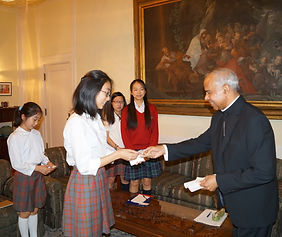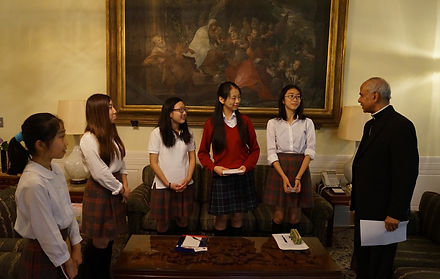バチカン市国
ローマ法王庁(教皇庁)大使館

2015年7月17日、インターナショナルスクールネットワークは、、バチカン市国の大使館ローマ法王庁(教皇庁)大使館にて、 the nuncio (papal ambassador) His Excellency Archbishop Mr. Joseph Chennothにインタビューしてきました。

大使館訪問と大使の背景 (大西 胡桃)
大使館にはキリスト教関係の装飾、絵画、写真が多くありました。大使館横には、美しい日本庭園があり、聖母マリアの白色彫刻を垣間見ることができました。 日本の季節の花、アジサイが満開でした。大使館に着いたとき、東京は小雨が降っていました。 しかし私たちが取材している間に雨が上がりました。そして私たちは素敵なお庭を楽しむことができました。
HE Mr. Joseph Chennothはインドご出身です。彼はインドで学ばれ、ローマで哲学と神学の研究を深めました。彼は中央アフリカ共和国、チャド、およびタンザニアのように、多数の異なる国で仕事をしてきました。 大使は英語はもとよりイタリア語ヒンディー語、フランス語、スペイン語、ドイツ語、ラテン語を話すことができます。彼は世界についての深い知識を持って、ローマ法王、バチカン市国ためだけでなく世界平和を促進しています。





バチカン市国の緑化 (まどか)
バチカン市国は、歴史的に重要な側面を持った、世界で最も影響力のある国の一つです。バチカン市国の広大で美しい庭園は、国土の半分以上を占めていいることが最大の特徴です。庭にはマリアの彫刻など、木々、噴水、および彫刻が美しく配置されていると話されていました。 庭全体を歩くのに約30〜40分かかり健康的な散歩できるそうです。おそらく、ローマ教皇のために作られたとのことです。
The new encyclical of Pope Francis was published two weeks ago, stating “Care of Earth, our common home”. This means that Earth is the common home of all humans, and so it is important for us to take good care of the planet. HE Archbishop Mr. Joseph Chennoth mentioned that this mentality is very similar to the Japanese value of living in harmony with nature. Nature is very important in the Vatican, as it is believed that people should treasure and value what is God’s creation. Christianity teaches that the seas, mountains, lakes, and forests are all God’s gifts to humankind, and so it is important to preserve them for future generations. This is demonstrated by the Christian cultural values of justice and responsibility.
Vatican City is taking various measures to reduce carbon emission. HE Archbishop Mr. Joseph Chennoth says that it is important for the whole world to maintain a clear atmosphere. Vatican City has placed solar panels on the Paul VI Audience Hall, introduced by Pope Benedict, and established the Vatican Climate Forest located in Hungary. Vatican City aspires to set a world example of safeguarding the planet, encouraging not only Christians but all of humanity to work towards a carbon-free environment.


Aspects of Culture (Madoka)
Children in Vatican City travel to Italy to go to school. There are a few families living in Vatican City; the families of the Swiss Guards, one of the oldest armies in the world. Papal Swiss Guards were founded in 1506, and are very loyal and disciplined as they work to protect the Pope. These Swiss soldiers are single males with Swiss citizenship, who have experience in Swiss military training, have a degree in higher education, are between the ages of 19 and 30, and have a height taller than 174 cm. They have a very unique uniform of the colors blue, red, orange, and yellow.
Astronomy has a very rooted importance in the Vatican. There is an academy in Vatican City for astronomy, with members who are eminent scientists from all over the world. HE Archbishop Mr. Chennoth introduced to us that there are two or three Japanese scientists who take part in this organization. Scientific data is discussed for a greater understanding of stars and the cosmos. There is an observatory located in the Vatican City, but currently the Vatican uses their observatory in Arizona, USA.





Cultural values (Kate)
Vatican City is the centre of the Catholic Church, home to the Pope and Holy See. To preserve the state as a religious land, the Vatican city works to conducts its visitors to show reverence and respect towards the Catholic church. One of the approach is the very clear dress code the church requires the tourists when entering the Vatican city. The appropriate dress for the Vatican state is to have shoulders and knees covered, applying to both men and women. Wearing shirts with violet graphic printed, and putting on excessive jewelries are banned as it does not match the religious manner. The use of mobile phones is also prohibited, as Father Federico Lombardi, the Pope’s spokesman, stated in nov 2008 :“There is an interior and spiritual dimension of life that must be guarded and nourished.” This rule significant to keep the holy sea a place for an individual to have a moment of silence in a sacred atmosphere.
Along with the idea to preserve the holy sea, the cultural values of the people in Vatican are based on the beliefs of the Christianity. They centrally cherish freedom, human dignity, solidarity, friendship, and equality, the ideas towards building peace treasured by the Catholic belief. Every person in Vatican shows the same dignity throughout the whole state. To take these cultural values in action, one of the most important objective as human being is to take care of others. His Excellency Archbishop Mr. Joseph Chennoth stated in the interview to take good care especially to those who are weak, poor, in segregation and the disabled. Vatican City itself, as a nation does not have any economic or military interest. Instead, the state cherishes religious and spiritual motivations, valuing the of spiritual and moral thoughts of human beings. Although Vatican City is a very small state in size, it is a place with pure peace and sacredness that is necessary for the world in order to maintain peace.
World peace is what people throughout the globe have been looking forward to for many centuries. However, without the understanding of how peace is essential, people would not move towards accomplishing peace. This is why vatican contentious to preach peace, the main purpose for the holy sea and Vatican. The prayer “May peace prevail on Earth” is to wish for a place where smiles and happiness are shared equally among the globe. As an ambassador and an archbishop, HE Mr. Joseph Chennoth is especially responsible to bring peace to all the people in the world. To share peace brought by the christ to all people in the world. As a step for world peace, the pope continues to speak for moral authority for the whole humanity. He asks for understanding the need for solidarity and friendship.




Exploring Japan and Its People (Kurumi)
In 1582, four young Japanese boys were sent from Nagasaki to Europe by a Japanese Christian Lord Ōtomo Sōrin. They were presented to the Pope and kings as the Tenshō Embassy. They went to Lisbon, Madrid, Florence, and Rome in order to learn more about Christianity and spread the ideas to Japan.
HE Archbishop Mr. Joseph Chennoth feels that the actions the young men took to understand and expand the knowledge of what they believe in, is an example of how open-minded and adventurous Japanese people are. He believes that this action represents Japanese people’s desire to discover the world and how they are open to know about more things. He said that they have the ability to assimilate into a new society and build onto them. HE Archbishop Mr. Joseph Chennoth has a very good impression of Japanese people. He mentioned that Japanese people are nice, hospitable, and hardworking. He especially likes the idea of “omotenashi (to welcome guests wholeheartedly)” and the spirit of sacrifice that he feels that many Japanese people have.
He hopes that Japanese people understand that the Pope works to promote education, justice, and peace throughout the world. “The Pope was appointed by Jesus Christ and he is the one who represents the message that comes from Jesus. He is the messenger for core,” he says. “The universal message is that there is one common father. We are all brothers and sisters. We love and help one another, especially the ones who are in need of our help.”
HE Archbishop Mr. Joseph Chennoth wishes the Japanese visitors to see the artworks and experience the welcoming nature of omotenashi. In addition, he hopes visitors will be able to see the motivation behind their nature, which is working for the supernatural spirit of love and charity inspired by Jesus Christ. This could be demonstrated by the loving of neighbors for the common good and the respect for human dignity as God’s creation.




日本の学生へのメッセージ (まどか)
The message HE Archbishop Mr. Joseph Chennoth has towards young students is to concentrate well in studying and to be open to other cultures. He believes that openness to different people and languages is very important in the understanding of others. HE Archbishop Mr. Chennoth himself has interacted with people in many different parts of the world, as he has learnt seven different languages. Although it is important to assimilate with different cultures, he comments that it is particularly important not to be swept away by the other cultures and to be aware of your own identity.
記事
仁科 まどか
清水 けえと
大西 胡桃


Reported by Karen
INTRO.
On the 17th of July the international school network went to the Vatican City embassy. The international school network asked questions about Vatican city to the ambassador as the ambassador replied to our questions. Vatican city is a small city. It has very few families and very few people. There are no schools in Vatican city so the children go to school in Italy. Vatican city is very important. Vatican city prints symbols in stamps, plates and others. They are very nice.
GARDENS.
Vatican cities gardens are very big, it almost fills the state. There are many trees, fountains, and flowers. The air is nice and fresh.
TAKE GOOD CARE.
Earth is Vatican city's common home. We have to take care of Earth and the stuffs. Giving an example to for the next person. To set a good example. Care of the common home, take good care. Everyone should be equal, and friendly. All the countries should be equal. Everyone should help people.
TOURISM.
The tourists come for selling stamps, and other things. There are many portraits in Vatican. The tourists should come to visit museums and other great places in Vatican city.
JAPAN IS.
The ambassador thinks that Japanese are very kind, very nice, respectful, and the ambassador loves the omotenashi system in Japan.
MESSAGE.
The ambassador has a message for the students which are to concentrate on studying, be open to all the cultures of the world, and keep your own identity.
記事
仁科 かれん
取材前 千代田区立四番町図書館 取材内容最終打ち合わせ


取材後 千代田区立四番町図書館 大使のお話を記事としてまとめる
取材メンバー
仁科 まどか 高校2年生 サンモール インターナショナル スクール
清水 けえと 高校2年生 清泉 インターナショナル スクール
大西 胡桃 高校2年生 サンモール インターナショナル スクール
仁科 かれん 小学6年生 サンモール インターナショナル スクール




